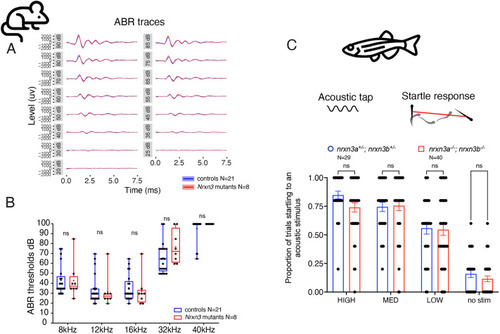
Auditory behaviors are unaltered in mouse and zebrafish after loss of Nrxn3. (A) Average auditory brainstem responses (ABRs) from control and Nrxn3 mutant animals (Atoh1-Cre; Nrxn3flox/flox) at P28-P32 from 20 to 90 dB are shown. (B) No difference was observed between control and Nrxn3 mutants with regards to the ABR threshold at any frequency tested. n=21 control and 8 Nrxn3 mutants. Distributions are framed with 25-75% whisker boxes where exterior lines show the minimum and maximum, the middle line represents the median, and + represents the mean. (C) A vibrational acoustic tap stimulus was used at three stimuli of decreasing intensity to trigger an escape response in nrxn3a+/−; nrxn3b+/− double heterozygotes and nrxn3a−/−; nrxn3b−/− double mutants. The proportion of times (out of five trials) an animal responded to each stimulus is shown. No difference was observed at any stimulus intensity. n=29 nrxn3a; nrxn3b double heterozygotes and 40 nrxn3a; nrxn3b double mutants at 5 dpf. Data are mean±s.e.m. A two-way ANOVA was used in B and C. ns, P>0.05.
|

